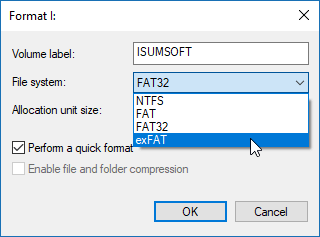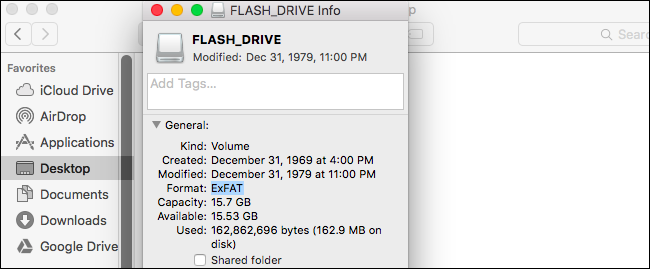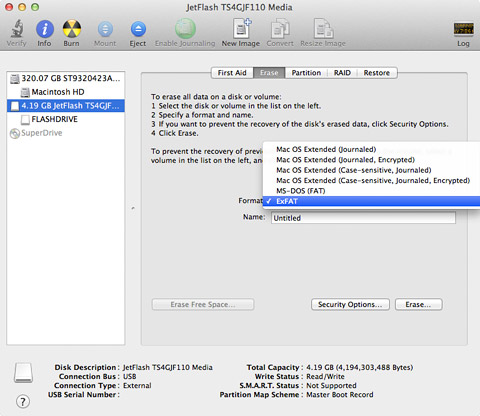

- #HOW DO CHANGE TO EXFAT ON USB FOR MAC MAC OS#
- #HOW DO CHANGE TO EXFAT ON USB FOR MAC UPDATE#
- #HOW DO CHANGE TO EXFAT ON USB FOR MAC WINDOWS 10#
- #HOW DO CHANGE TO EXFAT ON USB FOR MAC PRO#
So it seemed, The Golden Rule still applied. One is the replacement of the correct GUID partition type with Microsoft's partition type GUID of EBD0A0A2-B9E5-4433-87C0-68B6B72699C7.

When running Windows partitioning software, this can cause many possible side-effects. Since the Windows software can now read these partitions, the software believes the partitions are Microsoft type partitions. Windows Support Software, among may other things, allows Windows read-only access to certain Mac formatted partitions, such as "Mac OS Extended (Journaled)". This reason has to do with bugs introduced by the installation of Apple's Windows Support Software.

One would think this would negate The Golden Rule, but for a different reason, this rule lived on. When this method is employed, the hybrid MBR/GPT partitioning scheme is not used. This could (and often did) lead to corruption of the partitions stored on a drive.Įventually, Apple adopted the newer EFI boot method for Windows.
#HOW DO CHANGE TO EXFAT ON USB FOR MAC UPDATE#
Essentially, the diskpart and diskmgmt.msc commands would ignore the GUID partition table (GPT) and only update the MBR partition table. The Golden Rule was created because of this hybrid arrangement. In order for this to occur, a hybrid MBR/GPT partitioning method was employed. Originally, Mac computers could only BIOS boot Windows. Note: The diskmgmt.msc command displays the "Disk Management" window. Never use the Windows diskpart or diskmgmt.msc commands to change the partitioning on a Mac computer. Issues Regarding Using Windows Partitioning Tools on a Mac Computer.īelow has been referred to as THE GOLDEN RULE. Note: If you are clever, you can cut-and-paste from the output of the help set command to enter the set id=EBD0A0A2-B9E5-4433-87C0-68B6B72699C7 command. The detail partition command should show the incorrect partition type value of 48465300-0000-11AA-AA11-00306543ECAC. If not, then make the appropriate substitution. This will correct the error in the partition table.īelow I assume the USB stick (flash drive) is disk number 1. You could goto back to your machine running Windows, open a Administrator Command Prompt Window and enter the following commands. Microsoft Windows will not care, but Apple macOS does.Īlthough, you do not show this in your question, the GUID for this type of partition is 48465300-0000-11AA-AA11-00306543ECAC. Therefore, the partition table has partition type error. What should have appeared is Microsoft Basic Data. In your question, the output from the diskutil command shows the ExFAT formatted partition to be Apple_HFS. Therefore, Windows generally does not look at the partition type, but rather looks at the content of the partition to determine the file system. For example, both the ExFAT and NTFS files systems map to the same partition type. The mapping from a partition type to a file system is not always one-to-one. Usually, but not always, this is a file system. The type indicates what the partition will contain. Any idea what to do without reformatting and loosing the data on the stick? Is there any option to manually mount the filesystem as exFAT using command line?Įach partition on a drive is assigned a type. I have no idea why the volume is not mounting correctly. Running fdisk tells: bb-8:~ arne$ sudo fdisk /dev/disk2ĭisk: /dev/disk2 geometry: 7651/255/63 Or from command line: bb-8:~ arne$ diskutil list
#HOW DO CHANGE TO EXFAT ON USB FOR MAC MAC OS#
Instead the disk utility tells me it contains kind of Mac OS extended file system (German, sorry) but unable to mount (also information looks strange):
#HOW DO CHANGE TO EXFAT ON USB FOR MAC PRO#
My MacBook Pro running MacOS 10.13.2 cannot mount it.

#HOW DO CHANGE TO EXFAT ON USB FOR MAC WINDOWS 10#
The stick mounts without any problems on a Windows 10 system. I got a 64GB USB Stick formatted as exFAT from Windows containing a lot of files.


 0 kommentar(er)
0 kommentar(er)
